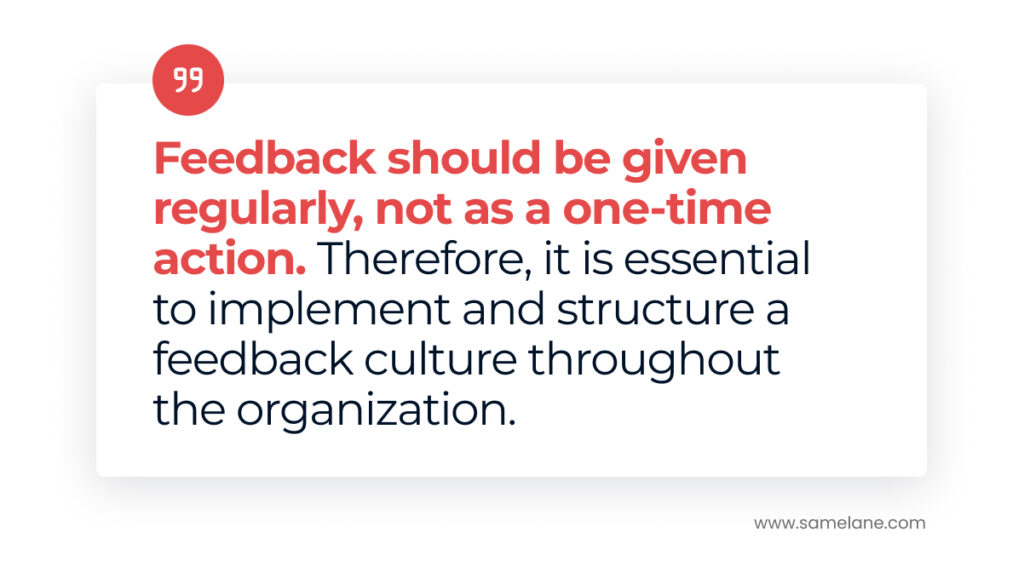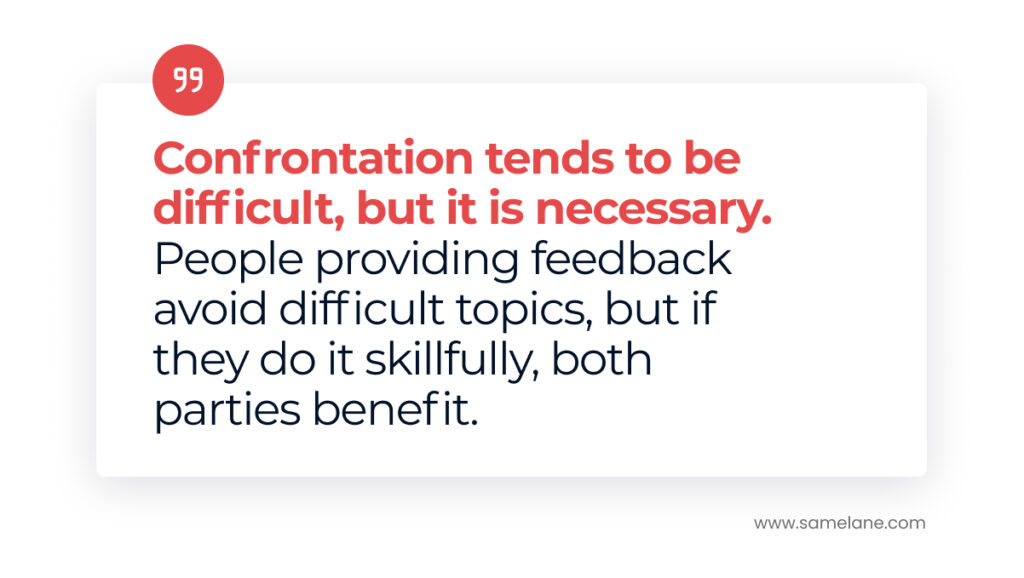Constructive feedback is an assessment provided in a way intended to be helpful, supportive, and informative. It is supposed to be a valuable commentary designed to help the recipient improve their performance, skills, or behavior rather than simply criticizing or blaming them. Constructive feedback should be specific, focused on the behavior or performance being addressed, and provide actionable suggestions for improvement. It should also be delivered in a respectful and non-judgmental manner, with the goal of building trust and encouraging growth and development. In a nutshell, constructive feedback is a valuable tool for helping individuals and organizations achieve their goals and reach their full potential.
In this article, we will discuss constructive feedback as a form of communication focused on providing specific and actionable feedback to employees to help them improve their performance, skills, and overall effectiveness. In addition, we will focus on the way it should be delivered to help the employee grow and develop professionally.
What’s the purpose of constructive feedback?
Constructive feedback should focus on the employee’s behavior or actions rather than their characteristics or traits. It should be based on observable facts and specific examples rather than assumptions or generalizations. Additionally, it should be provided in a timely manner and include specific suggestions for improvement. For your feedback to be perceived as constructive, it ought to consist of the following:
- Providing specific feedback on an employee’s work product, highlighting areas of strength and areas for improvement.
- Suggestions for how employees might improve their communication skills, such as being clearer or more concise in their messages.
- Identification of areas where an employee might benefit from additional training or development opportunities.
- Acknowledgment of employee’s strengths and suggestions for how they can continue to build on them.

counter the Big Quit with high retention strategies
We have asked our Senior HR Business Partner about the importance and essential elements of constructive feedback, and here is what she shared: “Most importantly, feedback, in general, should be given regularly, not as a one-time action. When it is negative and confronting the employee, provided once, it might feel more like a bomb dropped. Therefore, it is essential to implement and structure a feedback culture throughout the organization, to incorporate it into the company’s DNA. This is only possible by ensuring a regular exchange of information with employees, which, according to various studies, such as McKinsey, translates into increased commitment and efficiency at work. The prerequisite for an effective exchange of information with employees (because it’s best when the feedback conversation engages both parties) is voluntariness and a sense of security and trust in the interlocutor (Manager/Leader, HR), as well as a belief in their power and willingness to build the best possible workplace.” (Ewa Laskowska, HR & EB Manager / HR Business Partner, based in Wrocław)

The benefits of constructive feedback
Organizations are constantly seeking ways to improve and excel, and so do most of the employees. One invaluable tool that fuels personal and professional growth is constructive feedback. Far from being a mere critique, a manager providing constructive feedback offers a pathway to enhanced performance, increased self-awareness, and strengthened relationships. By embracing the power of feedback, individuals can unleash their full potential, while teams and organizations can foster a culture of continuous improvement. In this article, we explore the multitude of benefits that constructive feedback brings to the table, unveiling its transformative potential in unlocking growth and success for individuals and teams alike. Constructive feedback may bring your organization numerous benefits, such as:
- Improved performance: It can help recipients improve their performance, behavior, or approach. By pointing out specific areas that need improvement and offering suggestions on how to address them, feedback can help the individual grow and develop.
- Increased motivation: It can also serve as a motivator for the recipient. When feedback is delivered in a supportive and positive way, it can encourage the recipient to continue striving for excellence and to take ownership of their improvement.
- Self-awareness: Well-formed feedback can help individuals become more self-aware of their strengths and weaknesses. When feedback is delivered in a way that highlights what the individual is doing well and areas for improvement, it can help them gain a more realistic understanding of their capabilities and limitations.
- Communication: Constructive evaluation can improve communication between team members or colleagues. Feedback delivered respectfully and thoughtfully can create a culture of open and honest communication that fosters collaboration and mutual respect.
- Retention: Finally, it can also help retain talent. When employees feel that they are being supported and provided with opportunities to grow, they are more likely to remain engaged and committed to their work.
Constructive feedback is essential for managers and supervisors to help employees grow and develop in their roles while improving overall team performance and productivity. It is a key tool in creating a continuous improvement and learning culture and is essential for personal and organizational growth. On top of the obvious advantage for business, there are still some more benefits for the employee to gain on a personal level. Besides improved performance, increased motivation, and enhanced communication, constructive feedback leads to increased job satisfaction resulting from the development possibility and identification of personal growth areas. Acknowledging hard work will also boost morale and strengthen the working employee-employer relationship built on open communication.
How to give constructive feedback?
Giving constructive feedback is an essential skill that can help individuals improve their performance and achieve goals. However, providing critical or negative feedback can be challenging, and if not delivered constructively, it can be counterproductive. So, how to do it properly? We’ve gathered some do’s and don’ts from our HR department, and here they are.
How to make your feedback constructive:
- Be Timely: Provide feedback after the behavior or action occurs as soon as possible. This can help the person understand the impact of their actions and make changes more quickly. Remember, though, to give a heads-up about the planned meeting.
- Be Specific: Provide specific examples of behaviors or actions you want to address. This can help the person understand the issue and take appropriate action to improve. Prepare to give feedback, and plan ahead what you’re going to say.
- Be Clear: Use clear and concise language to communicate the feedback. Avoid using jargon or technical terms that the person may not understand. Call a spade a spade, even if it seems tough.
- Focus on Behavior, not Personality: Focus on the behavior or actions that need improvement rather than making personal attacks or criticisms. This can help the person feel less defensive and more open to feedback.
- Use one of the Communication Techniques: Start with a positive comment or observation, then address the area for improvement, and end with another positive comment or observation. The sandwich method can help balance the feedback and make it more palatable, though there are plenty more techniques to choose from. You may find SBI (the Situation-Behavior-Impact method), DESC (Describe, Express, Specify, and Consequences), or EDGE (Explain, Describe, Give, and End Positively) more suitable, depending on your case.
- Listen: Allow the person to respond and ask questions. Listen to their perspective and be open to their feedback as well. This can help build trust and strengthen the relationship.
- Use “I” Statements: Use “I” statements to convey how you feel or how the person’s behavior has impacted you. This helps the person to understand your perspective without feeling attacked or criticized. Non-violent communication is always the right move.
- Balance Positive and Negative Feedback: Feedback should be balanced, highlighting the person’s strengths and areas for improvement. This helps to create a positive and supportive environment for growth and development. Your main objective should be laying out your intentions, feedback aims, and action points.
- Provide Actionable Suggestions: Feedback should include actionable suggestions that the person can use to improve. This could include training, coaching, or resources to help them develop their skills. Develop a recovery plan together with the employee.
- Follow-Up: Check in with the person after giving feedback to see their progress. Follow up on the action points you agreed on. This shows that you are invested in their development and can help to reinforce positive behavior.
Feedback practices to avoid:
Not all feedback is constructive. In the best scenario, you should focus on being specific, actionable, and respectful while avoiding being too critical, accusatory, or negative. Here are some examples of practices you should definitely avoid when trying to be constructive:
- Personal attacks: Personal attacks can be hurtful and unproductive. Rather than attacking the individual, focus on facts, business matters, and employee performance.
- Vague or general comments: Too general or vague feedback, such as “You need to improve your work,” is not constructive. Instead, specific feedback with clear examples is more helpful.
- Criticism without solutions: Feedback that only points out flaws and doesn’t offer solutions or suggestions for improvement is not constructive. It can leave the recipient feeling frustrated and demotivated.
- Accusatory language: Use neutral language that focuses on the behavior or performance being addressed rather than placing blame or making assumptions. Ensure not to accuse, judge or communicate with words like “you never” or “you always.”
- Feedback given in public: Providing input in front of others can be embarrassing and counterproductive. Instead, give feedback in a private, one-on-one setting.
- Negative tone: Use a positive and respectful tone that encourages growth and development. Refrain from comparing the employee to other team members.
- Excessive feedback: Focus on providing manageable and actionable feedback, and avoid overwhelming the recipient with too much information. Giving too much feedback can be counterproductive. It’s essential to provide an evaluation in a manageable and actionable way.
Providing difficult feedback
In some cases, delivering feedback might be a tough nut to crack, especially when you need to discuss a problematic situation and draw conclusions for further cooperation and a recovery plan. We have sought the opinion of our HR Manager & Business Partner, Paulina Leja, to get some valuable tips on providing the difficult kind of feedback. “We all need an external opinion, an objective assessment of our work performance. It is rather difficult to see that we’re doing something not quite right or, on the contrary, that we are really good at something. That’s why we need an external and objective evaluation. Managers should be open when giving constructive feedback; confrontation tends to be difficult, but in such cases, it is necessary. It happens that people providing feedback avoid difficult topics, not wanting to harm good relationships, but if they do it skillfully, both parties benefit. I advocate for radical honesty (following Kim Scott’s theory), a part of which is expressing opinions directly and presenting them empathetically to the employee. Another helpful method for giving difficult feedback is SBI; it assumes that we stick to the facts when talking about situation (S), talk about the behavior which followed (B), and move on to the consequences of the event and behavior. By sticking to these few steps, we are able to give objective feedback while showing human empathy”.

Enhance constructive feedback with an LMS
As we’ve highlighted numerous times within this article, constructive feedback is vital for personal and professional growth in the workplace. To foster a culture of continuous improvement, besides the mentioned practices and methods, organizations can leverage Learning Management Systems to facilitate the process of providing effective feedback. An LMS provides a centralized platform where managers can deliver timely and constructive feedback, track progress, and facilitate ongoing development. The features offered by LMS, such as communication tools, performance tracking, and personalized learning paths, empower both managers and employees to engage in meaningful feedback conversations that promote individual and organizational success. With the assistance of an LMS, organizations can nurture a feedback-rich environment that cultivates talent, enhances performance, and fosters a culture of continuous learning.












